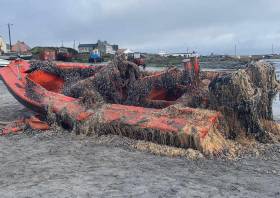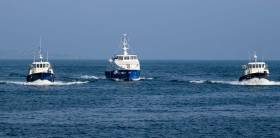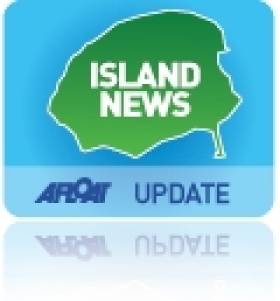Displaying items by tag: Doolin Ferry Company
Doolin Ferry Named 'Best Irish Boat Tour Operator' at Nautical Tourism Awards 2023
Doolin Ferry, a boat tour operator based in Doolin, Co. Clare, has recently been recognised for their services in the maritime tourism industry.
Doolin Ferry offers an extensive range of services, including a seasonal passenger ferry service to the Aran Islands, Cliffs of Moher Cruises, and private boat tours, providing unforgettable experiences to visitors and showcasing the natural beauty of the Clare coastline.
The company's commitment to excellence has earned them a 'Nautical Tourism Award'. This award aims to recognise and celebrate the achievements of companies operating within the maritime tourism industry.
Awards Coordinator Taylor Wilson commented: “This year’s Nautical Tourism Awards has seen a range of impactful businesses gain recognition for their commitment to customer care and curating trips of a lifetime”.
Speaking about the award, Liam O'Brien, owner of Doolin Ferry said, "Receiving the title of 'Best Irish Boat Tour Operator' is not just an award; it is a recognition of our team's hard work, dedication, and our ongoing commitment to providing the best possible experiences for our passengers. We are immensely proud of this accomplishment, and it motivates us to continually strive for excellence in all that we do."
The awardees are analysed and assessed by the LUXlife research team.
US ‘Rescue Boat’ Found Near Aran Islands Causes A Stir
An apparent coastguard vessel from the United States has washed up in the Aran Islands today (Tuesday 3 September).
In a post on their Facebook page, the Doolin Ferry Company reported spotting an object in the water on the way to Inis Oírr that turned out to be an upturned boat.
With the help of a local fishing boat and a number of islanders, the red boat was brought onto the beach and investigated for clues — the biggest being its serial number.
That identified the vessel as “Fast Military Rescue Boat”.
It’s not yet clear how long the boat has been in the water, and how it came to drift to Ireland’s shores.
But the ferry company’s appeal for more information has potentially identified it as boat built in 2015 for use in gunnery training by the US Navy.
David K Hunt of Alabama-based Silver Ships says the vessel is a “foam collar boat” used for target practice.
“We do air collar boats that are intended to sink, not float to Ireland,” he added.
Maiden Voyage into Doolin as Ferry Operations to the Aran Islands & Cliffs of Moher Commence
The Aran Islands got closer this week as the fastest and most eco-friendly passenger cruise ship to operate on the western seaboard sailed into Doolin for the first time following a €3m investment.
The Doolin2Aran operated ‘Star of Doolin’ completed the 650 nautical mile journey from La Rochelle in France and sailed into Doolin Pier in splendid morning sunshine to cheers from tourists and locals and - naturally for the North Clare village recognised as the home of traditional Irish music - strains of box, fiddle, banjo and pipes.
Following regulatory sign-off by Department of Transport officials, the boat was operating to the three Aran Islands and Cliffs of Moher by mid-afternoon.
 There were wild morning celebrations on Doolin Pier as the ‘Star of Doolin’ sailed in for the first time. Photo: Arthur Ellis
There were wild morning celebrations on Doolin Pier as the ‘Star of Doolin’ sailed in for the first time. Photo: Arthur Ellis
The ship, will be the fastest and largest to operate to the islands from Doolin, halving journey times and doubling capacity of the company’s existing boats. It has also been designed with the environment in mind, with additional features to lower emissions and state of the art waste water treatment on board.
The investment by Doolin2Aran, which is owned and operated by one of Ireland’s best-known sea families, the Garrihys from Doolin, is the biggest ever made in a single vessel on the west coast of Ireland. The one-off designed, 200 seat cruise ship is also tailored for international tourists, with multi-lingual voice commentary to ensure visitors get the absolute experience and knowledge of the world-famous heritage sites.
Hundreds gathered on Doolin Pier to welcome the ship back in, led by legendary Clare concertina player Chris Droney (93), who gave the boat its name. Chris is father in law of Eugene Garrihy – one of four Garrihy brothers with PJ, Joe and Donie involved in the business.
"Hundreds gathered on Doolin Pier to welcome the ship back in"
The 25m ship was sailed back from La Rochelle to Doolin, with an overnight in Dingle, at the weekend by skipper PJ Garrihy and his crew. They spent Monday night at the Aran Islands as locals, who will benefit from the investment through quicker journey times and more tourists, got a preview of the new vessel.
“It’s a great day for Doolin, for West Clare and for the Aran Islands,” said PJ Garrihy. “It was a lovely trip back. It’s such a comfortable ship and will be a great service to West Clare and the islands. We couldn’t wait to get her back and were blown away by the crowds on the pier for us so early today.”
Said PJ’s brother Eugene, “This is the end of an 18 month journey for us. We took the decision back in late 2016. It was a big move because we’re a small family business and it’s a very big investment for us but now that the ship is back, we’re delighted. It will be a huge boost to tourism in the West of Ireland but particularly here in Doolin and the Aran Islands.
“It ticks all the boxes. While it can take more passengers and operate at twice the speed, it has also been designed with the environment as a core consideration. We’re operating here out of the Burren and Cliffs of Moher Geopark and it was a priority for us to get emissions as low as possible and we’ve done that.”
Garrihy’s daughter Aoibhín, who is due her first child with husband John Burke, in three weeks’ time was also on the pier. “I’m very proud of what’s been achieved here. I got my first job here working in the summers and I just love the place. A lot of hard work, including in difficult times, has gone into this by the family, by people employed here and it’s great to seeing it pay off.”
Her grandfather Chris was in sprightly form, the celebratory mood even seeing him dancing a set on the pier. “I was here 70 and 80 years ago and there was nothing. Now it’s a thriving pier but it didn’t happen overnight. It’s great to see progress like this,” he said.
Auction of Aran Islands Passenger Ferry Sisters
Aran Direct (which was the trading name for Bád Arann Teoranta) operated on routes between Rossaveal to Inis Mór, Inis Meáin and Inis Oírr. The company competed in an intensely competitive market with at least 10 other vessels combined from the fleets of Aran Doolin Ferries, Aran Island Ferries and the Doolin Ferry Company.
In September 2008, Aran Direct ceased operations and the vessels were laid-up at Rossaveal, where they remain, as seen (if not previously sold) prior to the public auction.
At the instructions of Liam Dowdall Esq., Receiver & Manager, Bád Arann Teoranta (in receivership), the vessels are to be sold in one or separate lots. The public auction is to be held at 12 noon on Thursday 24th February at the Harbour Hotel, The Docks, Galway.
An outline of the vessels details can be downloaded in PDF format by clicking HERE. For further details, photographs and conditions of sale contact Dominic J. Daly, Auctioneer, Cork Tel: (021) 4277399 or E-mail: [email protected] and logging on to www.dominicjdaly.com
For further technical details, you can contact Noel O'Regan of Promara Ltd on 087 3435666 or email [email protected]


























































